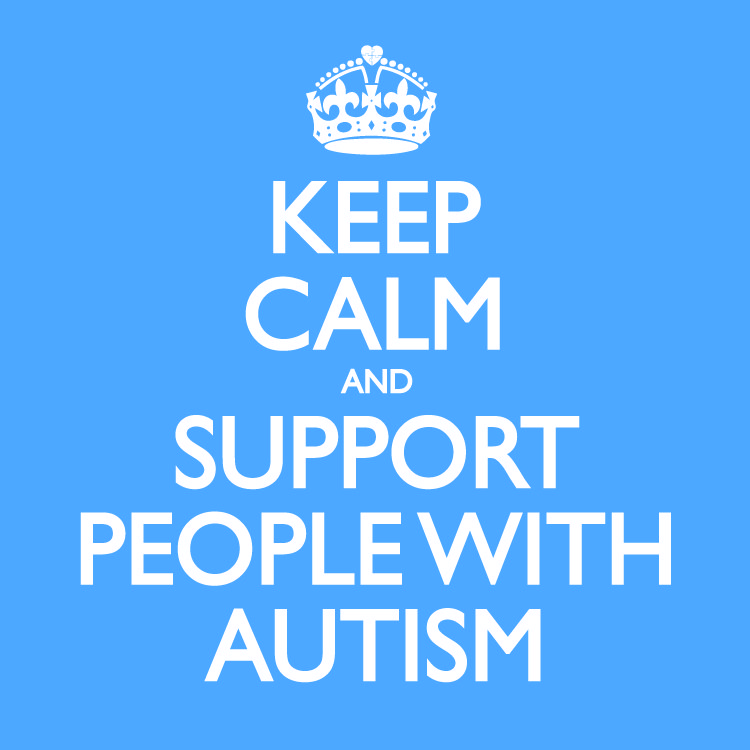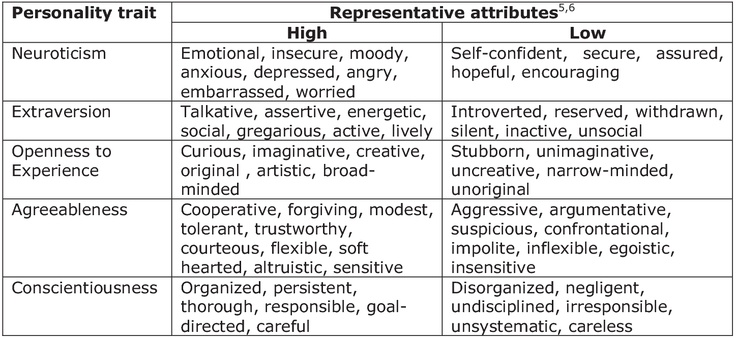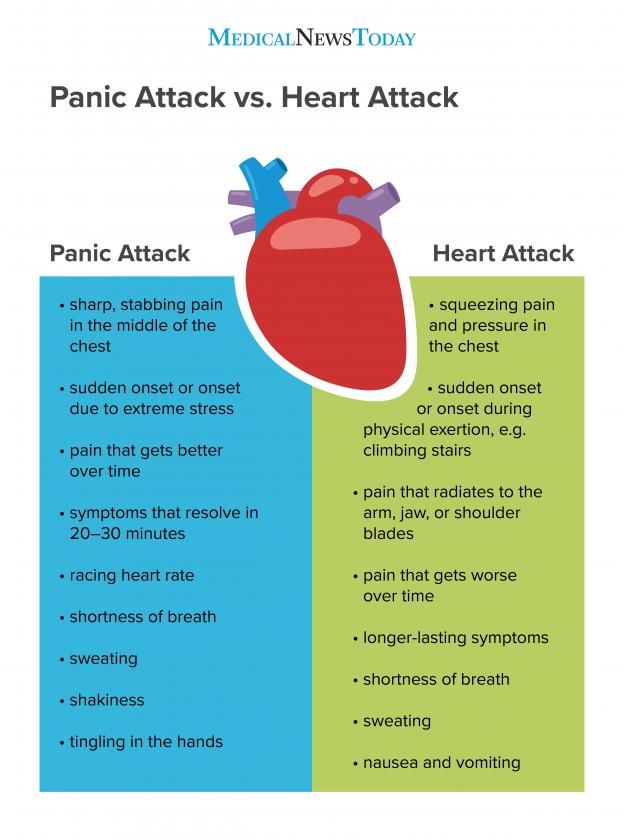How to calm autistic meltdown
a guide for all audiences
Many autistic people have meltdowns. The public often finds it hard to tell autism meltdowns and temper tantrums apart, but they are very different things. If your family member or the person you support has meltdowns, find out how to anticipate them, identify their causes and minimise their frequency.
What is a meltdown?
A meltdown is an intense response to an overwhelming situation. It happens when someone becomes completely overwhelmed by their current situation and temporarily loses control of their behaviour. This loss of control can be expressed verbally (eg shouting, screaming, crying), physically (eg kicking, lashing out, biting) or in both ways.
A meltdown is not the same as a temper tantrum. It is not bad or naughty behaviour. When a person is completely overwhelmed, and their condition means it is difficult to express that in another way, it is understandable that the result is a meltdown.
Meltdowns are not the only way an autistic person may express feeling overwhelmed. They may also refuse to interact, withdrawing from situations they find challenging or avoiding them altogether.
What to do
If someone is having a meltdown, or not responding to you, don’t judge them. It can make a world of difference to an autistic person and their carers.
- Give them some time - it can take a while to recover from information or sensory overload.
- Calmly ask them (or their parent or friend) if they’re OK, but bear in mind they’ll need more time to respond than you might expect.

- Make space - try to create a quiet, safe space as best you can. Ask people to move along and not to stare, turn off loud music and turn down bright lights – whatever you can think of to reduce the information overload, try it.
Anticipating a meltdown
Many autistic people will show signs of distress before having a meltdown, which is sometimes referred to as the “rumble stage”. They may start to exhibit signs of anxiety such as pacing, seek reassurance through repetitive questioning or physical signs such as rocking or becoming very still. At this stage, there may still be a chance to prevent a meltdown. Strategies to consider include distraction, diversion, helping the person use calming strategies such as fiddle toys or listening to music, removing any potential triggers, and staying calm yourself.
Identifying the causes
A meltdown is a reaction to an overwhelming experience. If your family member or the person you support has meltdowns, identify what is overwhelming for them. Complete a diary over a period of time. Record what happened before, during and after each meltdown. Patterns may emerge. You may find that meltdowns occur at particular times, in particular places, or when something particular has happened.
Minimising triggers
Once you have a clearer idea what may be triggering meltdowns, think about ways you might minimise that trigger. Every autistic person is different, but sensory differences, changes in routine, anxiety, and communication difficulties are common triggers.
Sensory considerations
Many autistic people have sensory differences. They may be over-sensitive to some senses, under-sensitive to others and often a combination of both.
For example, for someone who is over-sensitive to touch and sound, people brushing past them and a loud announcement at a train station could cause pain and sensory overload, leading to a meltdown. In this situation, it could be helpful to listen to calming music on headphones to block out loud noises and to wait until everyone has got off the train before approaching the platform to avoid crowds of people.
In other situations, consider creating a low arousal environment (eg remove bright lights) or use sensory equipment (eg glasses with dark or coloured lenses, ear defenders, a weighted blanket).
Change in routine
Consistent, predictable routines and structure are very important for autistic people and a change to routine can be very distressing.
For example, having to go a different route to school due to roadworks could cause feelings of anxiety, that may trigger a meltdown. In this example, a clear visual support explaining the change, reassurance that the rest of the routine remains the same and adding extra support such as a calming/comforting activity to do in the car could help.
For an unexpected change, there can be a particular plan in place, such as:
- the use of a picture symbol to explain the change
- reinforcement of the rest of the day being the same (if that’s the case)
- a chance to express any frustration appropriately (such as hitting a pillow, ripping paper) followed by an activity that is known to calm the person such as taking deep breaths, listening to calming music, going for a walk, or squeezing a stress ball.
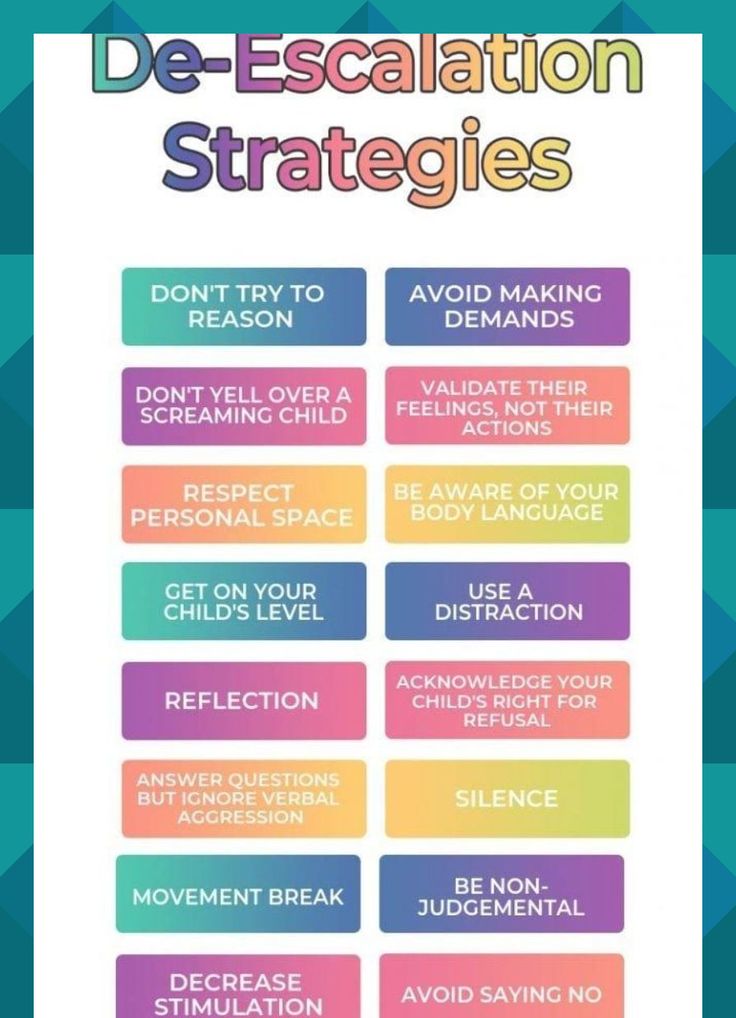
It may help to increase structure around ordinary transitions, helping the person to navigate the change from one activity to another throughout the day. Using a clear timetable explaining when the transitions will be, using timers to count down to transitions, using a favourite toy or character to be part of the transition, can all help.
Anxiety
With its unwritten rules and unpredictable nature, the world can be an extremely challenging environment for autistic people and many experience anxiety. Without tools and strategies to help manage their feelings of anxiety, they may experience a meltdown.
Develop strategies to manage anxiety, such as the Brain in Hand digital self-management support system.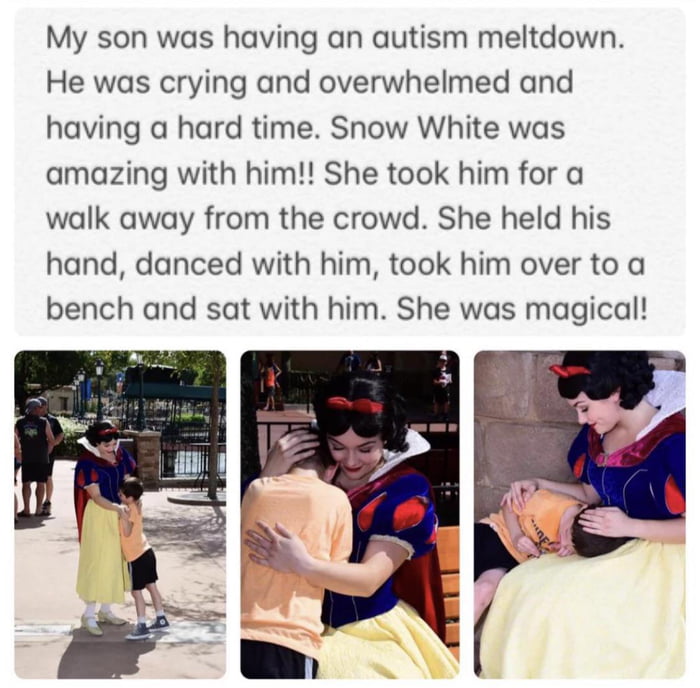
Have a plan beforehand of what to do if the person feels anxious, such as a calming playlist to listen to at the shops or a stress ball in their pocket.
Build relaxation time into the routine. The person will generally feel calmer and therefore better able to manage when something that could trigger a meltdown, occurs. What that means will vary from person to person, and may consist of quiet activities, eg taking a walk, listening to music, playing a computer game, reading, doing puzzles, using fiddle toys, or more strenuous activities, eg jumping on a trampoline or going to the gym.
In the case of more strenuous activities, observe whether the activity really does calm the person down. If it doesn’t, but is just an activity they really enjoy, still build in time for that activity but also try and find one that does genuinely calm them down and make time for that as well.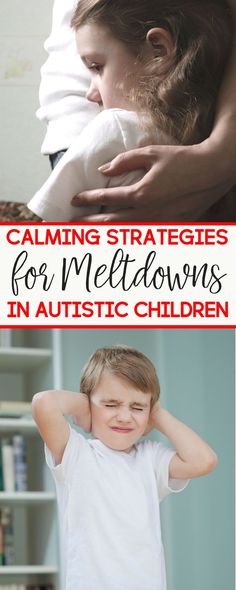
Communication difficulties
Autistic people can find it difficult to express their wants and needs, from a non-verbal child struggling to express their need for a drink to a teenager finding it hard to express their emotions. This can result in overwhelming feelings, such as anger and frustration, leading to a meltdown.
Support the person to find ways to understand and express their emotions appropriately before they get overwhelmed, and find ways to make your own communication more easily understandable. Some autistic people may find verbal communication difficult due to misunderstanding body language, tone of voice, irony and sarcasm.
Things you can try include:
- visual supports
- social stories
- Picture Exchange Communication Systems (PECS)
- written information
- modifying your verbal communication eg by speaking in short, clear sentences
- using technology such as tablets and voice software, instant messaging etc
- increasing understanding of emotions and social skills.
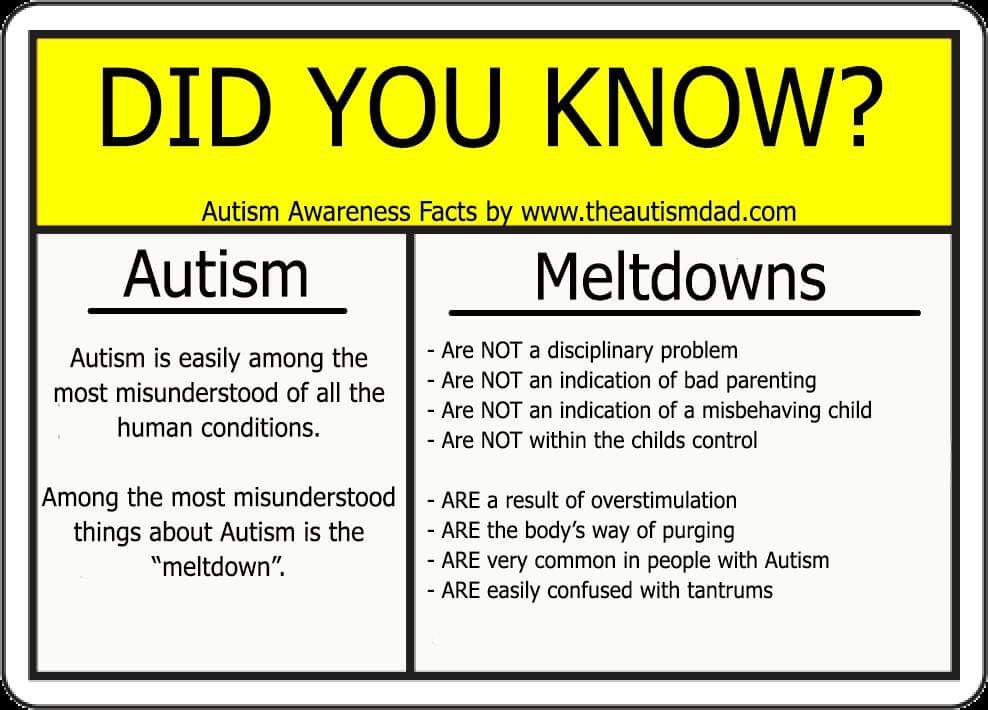
More from our charity
- Communicating and interacting
- Anxiety
How to Calm an Autistic Child During a Meltdown
It can get difficult to manage tantrums and meltdowns. Parents and caregivers who experience this, often wonder how to calm their autistic child.
We wanted to gather some information on what are meltdowns and tantrums, and how to deal with them.
What are the Causes of Meltdowns for Children with Autism?
We should first define what meltdown actually is. A meltdown is an intense response to overwhelming situations by the person.
This could happen when an individual is overwhelmed by the current situation. It could cause loss of control.
This can be exhibited in different manners. The loss of control shows through verbal expressions like yelling or crying, or it can be physical like kicking or biting.
The loss of control shows through verbal expressions like yelling or crying, or it can be physical like kicking or biting.
There are cases where the response could be in both ways.
Here would be a good place to point out that autism meltdowns and temper tantrums are actually not the same thing.
When you are looking into ways on how to calm an autistic child, you may come across tantrums as well.
There may be a couple of underlying reasons for having a meltdown. It can be triggered by so many different problems.
The key to understanding how to calm an autistic child lies with understanding what it is that triggers the behavior.
The following are some of the common causes of meltdowns:
-
ADHD: Lack of focus or inability to tolerate boredom can contribute to outbursts
-
Learning issues: A learning disorder could cause frustration and lead to meltdowns
-
Anxiety: This is another major contributor.
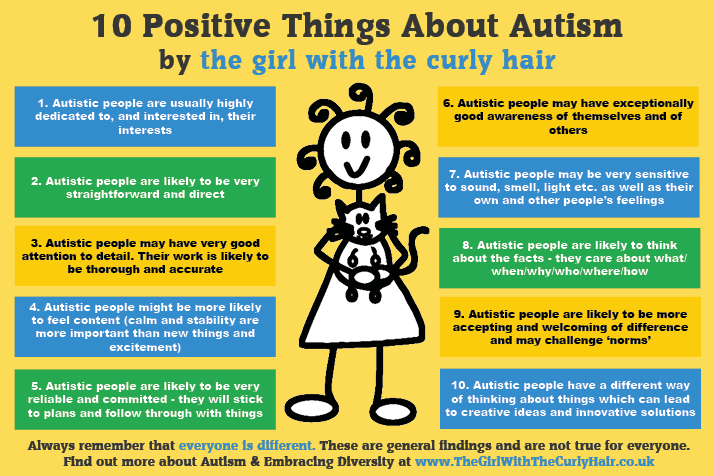 A child can get overwhelmed when faced with uncomfortable situations.
A child can get overwhelmed when faced with uncomfortable situations. -
Sensory issues: Sensory issues cause children to feel overwhelmed which leads to meltdowns.
-
Lack of skills to handle situations: Children who lack the skills to cope with certain situations or emotions could experience meltdowns.
Meltdowns are not the only way that an individual with autism can show they are overwhelmed.
Less obvious ways include refusal to interact, or withdrawing oneself from challenging situations.
What is the Difference Between Meltdown and Tantrum?
They may seem similar on the outside. Externally, meltdowns and tantrums look really alike. But there are in fact differences between the two.
Tantrums can be seen in younger children as __willful__ behaviors. Not that children plan to frustrate their parents or caregivers, but they want to express their frustration.
However, a meltdown can be experienced throughout life. While tantrums tend to go away as the child gets older, meltdowns may never go away.
It is important to note that children with autism can, of course, have classic temper tantrums. But, understanding the difference between tantrums and meltdowns can provide great insight.
Tantrums can be resolved through a certain kind of response, while the same response can overwhelm the child during a meltdown.
If you are looking for ways on how to calm an autistic child, understanding the difference between meltdowns and tantrums can come in handy.
There are a couple of ways to figure out the difference between the two:
Audience: When ignored, tantrum behavior usually stops . Or when the child gets what they want, they may stop the behavior. But an autistic meltdown will occur regardless of an audience, as it is a response to an overload of external stimuli causing emotional explosion. This could even happen when they are alone.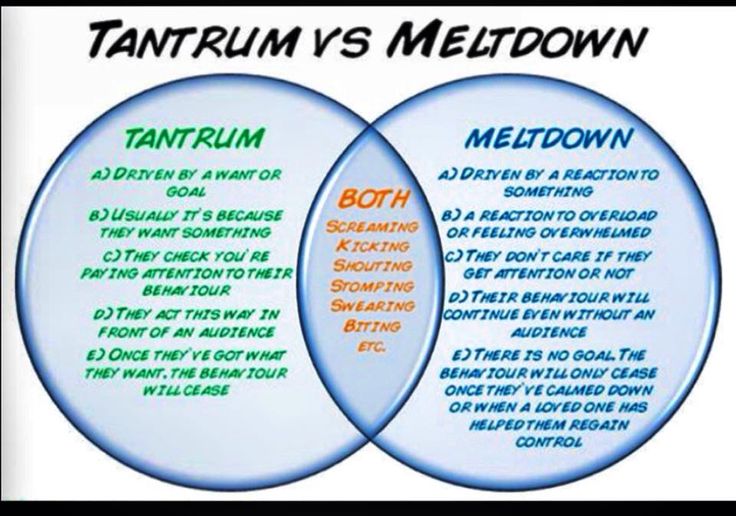
Angry vs. Overwhelmed: Tantrums stem from being angry or frustrated. But autistic meltdowns are generally a reaction to being overwhelmed. Autistic individuals can’t control their meltdowns. Strategies like hugs, incentives or distractions that work on tantrums will not be beneficial for meltdowns.
Getting What They Want: Tantrums could be goal oriented. This means that a tantrum in a young child is typically a result of getting what they want. This could be a toy or not doing a certain routine or eating only a certain type of food. These tantrums can be more frequent when the child is tired or not feeling well, but there is generally a goal behind it.
However, autistic meltdown is caused by being overwhelmed.
Triggers include:
- Sensory overload
- Emotional overload
- Informational overload
The external behaviors like crying or yelling similar to tantrums may occur.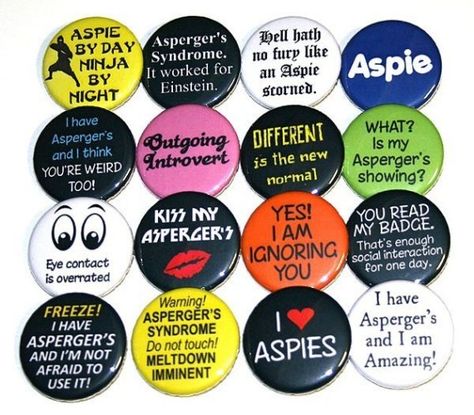 Or they can completely shut down.
Or they can completely shut down.
What Do Meltdowns Look Like?
Meltdowns can look different .) in each autistic person. The individual can withdraw, shut down, zone out, stare into space, or fall into repetitive movements.
They may also cry uncontrollably, scream, growl, bite, curl up into a ball.
Many individuals with autism will show signs of distress before having the meltdown. This is called the “ rumble state ”.
To calm themselves down, the individual may:
- Start pacing around,
- Ask repetitive questions,
- Rock back and forth,
- Become very still.
This could be the window to prevent a meltdown.
What Do Tantrums Look Like?
Tantrums differ from one child to another. They can be spectacular explosions of anger.
The child may “lose it” with frustration and disorganized behavior.
During tantrums , the child may cry, stiffen up, scream, kick things around, fall down or run away. Some children hold their breath, and some even vomit.
Some children hold their breath, and some even vomit.
They may break things around the house. Children with autism could get aggressive when they are throwing a tantrum fit.
This is how autistic children may express their frustration with the challenges that they are facing.
Thirst , hunger, tiredness: Some examples that can lead to tantrums.
When they get frustrated, they get angry. And when they get angry, they can throw a tantrum.
Come along with 200k+ families!
Let's communicate better!
Download for Free.
Certified speech therapy app
designed with SLPs.
Otsimo Speech Therapy
Download for Free
How to Calm Down an Autistic Child During a Meltdown?
A meltdown is generally a reaction by the individual as they are overwhelmed. The first thing in learning how to calm an autistic child is to identify what is actually overwhelming for them.
By identifying the trigger, the meltdowns could be prevented later on.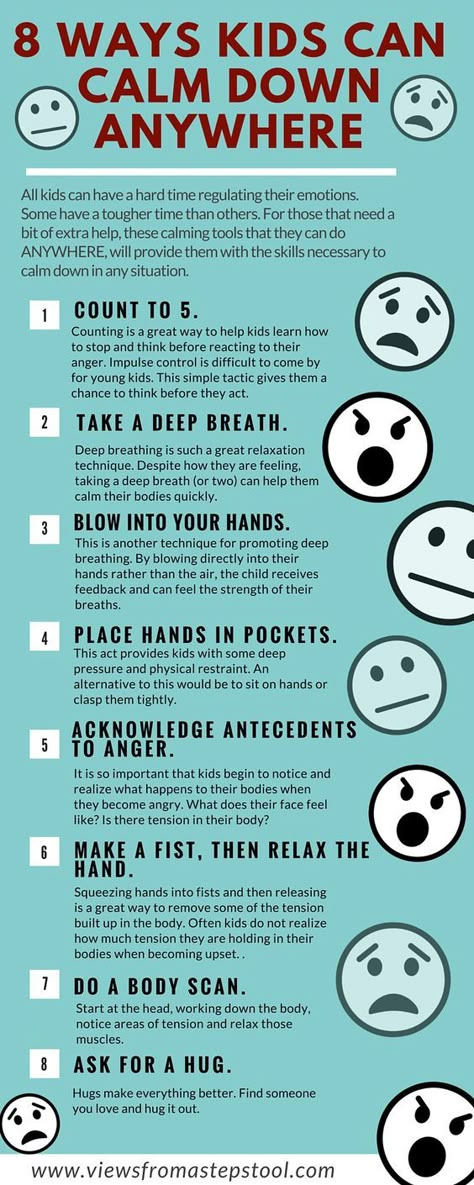 Keep a diary to see if meltdowns occur at particular times or places. However, there are also things to try while the autistic child is having a meltdown to calm them down. Here are some tips and strategies:
Keep a diary to see if meltdowns occur at particular times or places. However, there are also things to try while the autistic child is having a meltdown to calm them down. Here are some tips and strategies:
-
Have a calming routine: Although the meltdown could drain them of energy; having a calming routine in place for the autistic child could help them calm down further. This routine could include certain visuals that the child likes or music, or a weighted blanket they like.
-
Safety first: Meltdowns may unintentionally hurt both the child and others around them. Children with autism may, for instance, fall or hit their heads, or they could hit you or bite you. It may be a good idea to have a strategy in place to make it safe for the duration of the meltdown.
-
Keep a diary: Taking notes on when and where the meltdown occurs could help in preventing future ones.
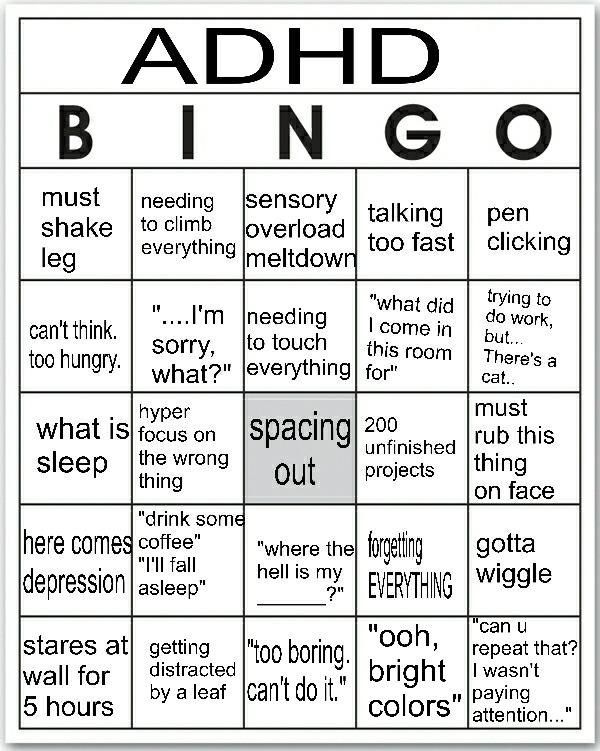 This could also be helpful in that you can see the signs of meltdown beforehand and start the calming routine to de-escalate the situation. If you understand what triggers meltdowns, you may be able to stop it beforehand.
This could also be helpful in that you can see the signs of meltdown beforehand and start the calming routine to de-escalate the situation. If you understand what triggers meltdowns, you may be able to stop it beforehand. -
Try to stay calm: It is important that you are not adding stress and escalating the situation more while your child is having a meltdown. They are tough, but meltdowns are part of autism. The best way to help is to learn to cope with them and have a strategy at hand.
-
Use items: Sometimes calming devices like a fidget toy could alleviate the effects.
-
Don’t be logical: Don’t try to reason with your child when they are having a meltdown. They are going through a stressful time as it is and they can’t be reasoned with until the meltdown is over. Be patient.
-
Always be there: Make sure that you are within reach of your child in case they want you during meltdown.
 Keep a neutral face and try to be calm.
Keep a neutral face and try to be calm.
How to Handle a Meltdown in Public
This can happen to anyone. Parents and caregivers could be low on patience while also hurting for their struggling child.
Remember that autistic children do not have meltdowns and cry or flail just to get at you.They cry because they need to release tension from their bodies in some way. They are overwhelmed with emotions or sensory stimulations.
There are some ways to effectively support your child when they are having a meltdown in public. Here are some of them.
Equip them with coping skills: Meltdowns can’t be helped at that very moment. But afterwards, you can teach your child how to regulate their emotions. Try relaxing activities like going for walks. These calming activities will help them calm down even before the meltdown happens.
Feeling safe and loved: Trying to talk a child down from having a meltdown is not a great strategy when it comes to calm an autistic child. Be there for them. Let them know that they are safe at that moment. Stay close as much as their comfort allows. Don’t leave them alone to be out of a meltdown and find no one in the room. This could send a message that they don’t deserve to be around the people they love when it gets tough.
Be there for them. Let them know that they are safe at that moment. Stay close as much as their comfort allows. Don’t leave them alone to be out of a meltdown and find no one in the room. This could send a message that they don’t deserve to be around the people they love when it gets tough.
Empathy is key: Listen and understand their situation. Tell them expressing emotions is okay, and sometimes it can get overwhelming. If your child with autism can feel like they are being heard, they will feel that their experience is validated. Try to give them tools to express themselves in a safe way.
Don’t punish: Punishment will get you nowhere. They can make your child feel more ashamed or afraid. They can’t control their meltdowns, so they should not be punished. Allow them the opportunity and space to feel their feelings and let them know you are there to support them along the way.
Have a sensory toolkit: You can keep a couple of sensory toys in your bag when you are going out.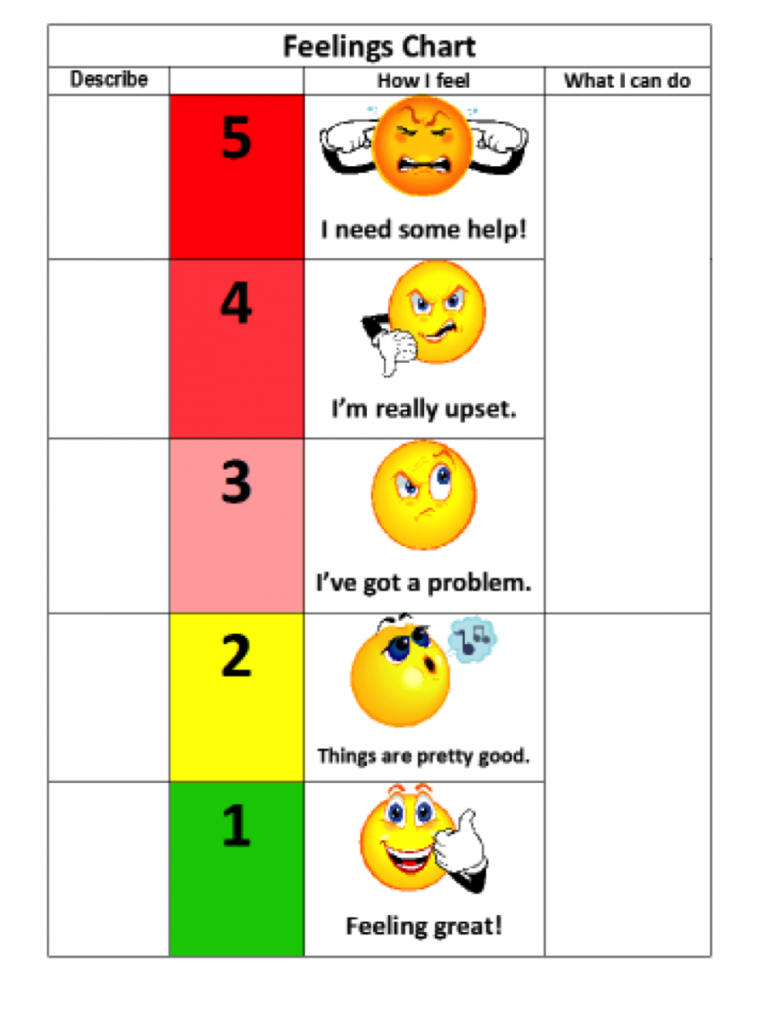 These will keep the mind of your child occupied when they are overwhelmed. Try not to force these to the child during meltdown.
These will keep the mind of your child occupied when they are overwhelmed. Try not to force these to the child during meltdown.
What to Do When My Child is Having a Tantrum?
1. Tantrum vs. Meltdown
Before you intervene in any way, try to figure out whether your child is having an autism meltdown or tantrum. As we discussed earlier, they may look similar but they need different approaches.
Meltdowns are a response to external stimulation, while tantrums can occur when a need is not being met.
It is important to distinguish the two before having a strategy to manage the situation.
2. Figure out the motivation
Understanding what lies behind the tantrum behavior will give you the key to manage it.
You will be able to respond to it more appropriately. They may want something, like a toy or attention. Recognize this want without giving it to them.
3. Remove the audience
Sometimes removing the audience from the environment, the tantrum will stop.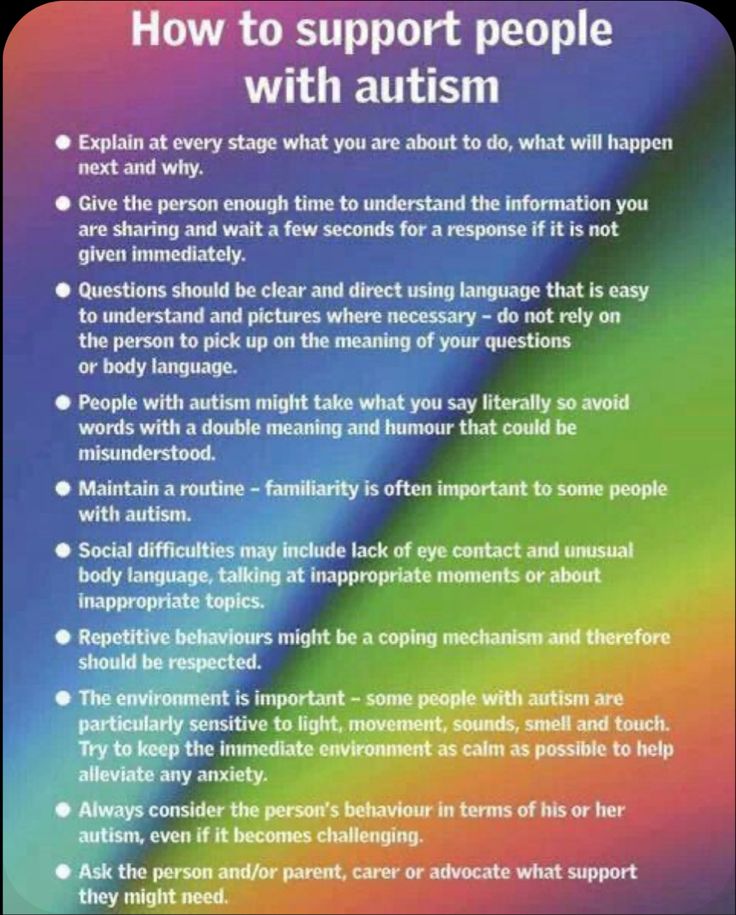 If you noticed this pattern, like your child tends to have tantrums in crowded areas, teach them coping mechanisms in small gatherings.
If you noticed this pattern, like your child tends to have tantrums in crowded areas, teach them coping mechanisms in small gatherings.
Try removing yourself from the environment (but still being a place where they can see you). It could also help reduce and stop tantrum.
4. Praise and reinforce positive behavior
Acknowledge the feelings of your child and praise them for their good behavior.
You can give them a hug, or tell them how they managed to do the thing well. These will avoid tantrum outbursts as your child will learn that they have your attention and can be successful in doing things.
5. Build the necessary skills
We have discussed before that tantrums can be caused by lack of certain skills like problem solving or negotiating.
Try to create opportunities to build on skills related to:
- impulse control,
- communicating wishes and needs,
- self-soothing,
- problem solving,
- delaying gratification
- negotiation.

You can try practicing them after tantrums.
Sensory Tools for Meltdowns
You can prepare a toolkit to take anywhere you go, in your car or in your bag, consisting of sensory tools to utilize during meltdowns. They will be able to help on some level. Here are some suggestions to put in your toolkit .
-
Noise-cancelling headphones. A pair of noise cancelling headphones can help calm an autistic child when the noise gets too loud for them.
-
Sunglasses. If your child has light sensitivity, a pair of sunglasses can help them when it is too sunny or the fluorescent lights are too bright.
-
Weighted blanket/lap pad. Pressure can be an answer to how to calm an autistic child. Weighted blankets and lap pads.
-
Snacks that are chewy or crunchy. Kids get crankier when they are hungry. Crunchy ones can help with oral proprioceptive input as a calming effect.
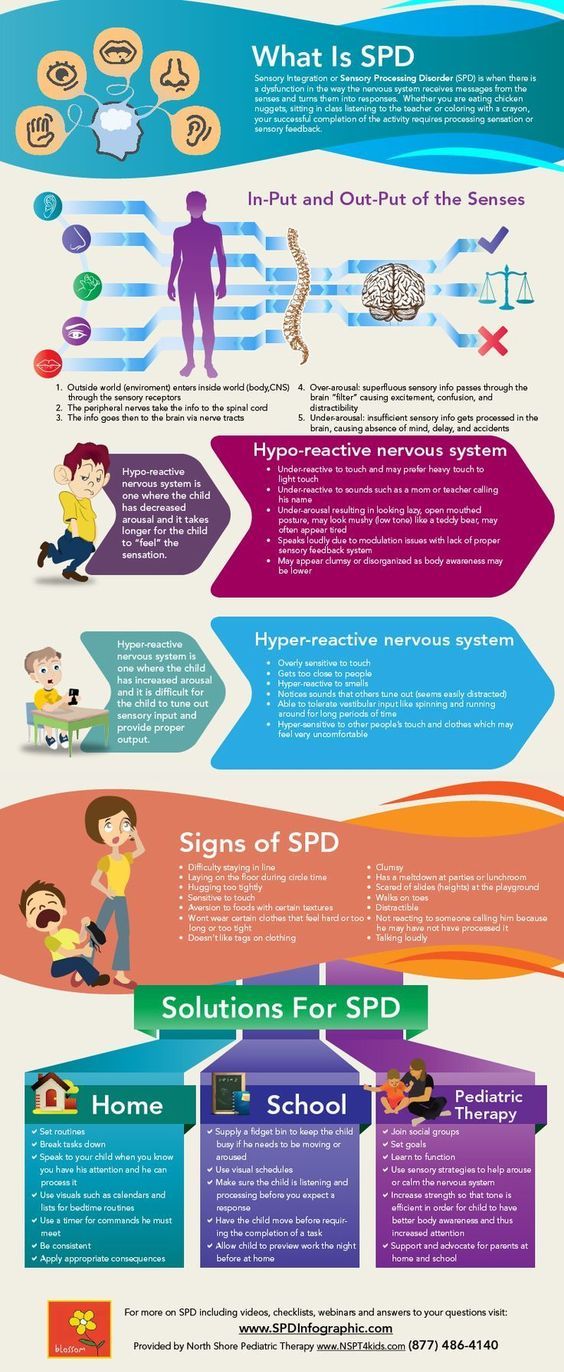 Or if your child likes chewy snacks, they are another way to go.
Or if your child likes chewy snacks, they are another way to go. -
Fidget toy. These are repetitive and simple tools that can offer calmness to your child when they get agitated.
-
Scented hand lotion. If some odors in the environment is too much for your child, you can use a hand lotion with a scent the child likes.
-
Hand wipes. Children with tactile sensitivities can accidentally touch something that can irritate them. These unscented hand wipes may help with this.
Tips from Other Parents of Children with Autism
Not all meltdowns and tantrums look the same on all children. Some of the tips and tricks as well as strategies mentioned in this article may not be suitable for your child while they can be helpful to others.
Remember that you are not alone. Tantrums and meltdowns are common in children with autism. You can get inspiration or support from other parents who are also dealing with this same issue.
The first thing parents suggest is to understand the difference between tantrums and meltdowns. They have noticed that when their child is having a meltdown, there is usually a trigger. They try to make a safe environment, like taking the child to their room, so that the child will not hurt themselves.
From what the parents or caregivers explain, sometimes the child can also select a place like a dark closet to have a meltdown where no one can reach them. But the parents always stay close and when the child is more comfortable, they try to help and comfort their child.
In the case of tantrums, sensory overload is generally not an issue. You should be looking for the motivation behind the tantrums. Parents state that tantrums don’t last as long as the meltdowns. Reinforcement and praise of positive behavior at this stage helped a lot of parents.
A popular method for soothing the meltdown used by a lot of parents and caregivers is weighted blankets and pressure. These have proven to be effective in calming the child down. Some stated that as their child got older, they managed to teach the child breathing exercises as well to help them self-sooth.
These have proven to be effective in calming the child down. Some stated that as their child got older, they managed to teach the child breathing exercises as well to help them self-sooth.
Another tip from the parents is related to stimming. There are some stim toys and fidgets the child can use. Make sure to keep a couple around and have them be something the child is interested in. Parents suggest that if you can catch the meltdown at its early stages with these stim and fidget toys, it becomes much easier to stop it.
Parents or loved ones of the child with autism also have suggestions on making the environment safer for when the child is having a meltdown. You can remove items that can hurt them and cushion their surroundings by putting a pillow if they start to bang their heads. They suggest trying not to speak to them or touching them during the meltdown as this may make things worse.
Also, parents and caregivers state that children feel exhausted and embarrassed after the meltdown is over. Try to convey them that you understand how they feel and ask them if they want a cuddle or a glass of water.
Try to convey them that you understand how they feel and ask them if they want a cuddle or a glass of water.
You can also speak to your child about their feelings, and let them know it is okay to have those feelings.
Last Updated: 23 December 2022
How to deal with tantrums of a child with autism in public places?
02/05/14
Recommendations of a children's psychologist for prevention and response to behavioral crises of autistic children
Author: Lauren Elder
Source: Autism Speaks
9000 9000
9000 9000 for all. However, it is especially difficult to deal with it if it has been stepped on in a public or crowded place. Here are some tips for parents whose kids are prone to tantrums in public.
Children with autism especially benefit from visual cues and social stories to help them better understand your expectations. You can write a separate social story for each visit to a public place that you and your child will have.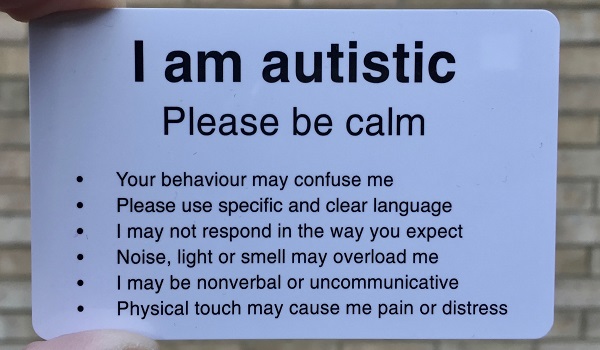 For example, it could be a story about how a child goes to the grocery store with his mother, and how he does not like that it is too noisy there. He wants to scream, but instead he asks his mother for help. She gives him a big hug to help him calm down and tells him that they will leave the store in 5 minutes and also offers him some earmuffs.
For example, it could be a story about how a child goes to the grocery store with his mother, and how he does not like that it is too noisy there. He wants to scream, but instead he asks his mother for help. She gives him a big hug to help him calm down and tells him that they will leave the store in 5 minutes and also offers him some earmuffs.
You can use pictures to tell your child a story or otherwise communicate your expectations of their behavior. For example, you can make a special card that your child can give you when he feels too stressed and needs a break.
When visiting a public place, you can use a series of pictures to support you, illustrating the upcoming event step by step. This will help the child to understand in advance what awaits him. You can use a now-then board with two pictures illustrating what will happen now and what will happen next. For example, in the first picture the child is sitting quietly in a restaurant, and in the second picture there is a reward that you promised him for good behavior.
Preliminary practice. Role-play a trip to the store, library, restaurant, or any other place you plan to take your child. Help your child practice good behavior during role play. Lose and the occurrence of potential problems. These problem rehearsals can help your child get through a long line or come to terms with their favorite toy not in the store.
Start small. It is best to start small, return home as soon as possible, or return to this place after a long break. So if you are planning your first visit to a restaurant, then order only an appetizer, dessert or drink, and then leave. When returning to the grocery store after a long break, grab just one item and head straight home. Gradually increase the time the child spends in public places, determining his readiness by his behavior. Remember, one success leads to another.
Get your child involved. Help your child be as active and responsible as possible when visiting public places. For example, instruct him to put all the goods in a cart in a supermarket. Or let him choose a book from the library himself.
For example, instruct him to put all the goods in a cart in a supermarket. Or let him choose a book from the library himself.
Have toys or other items ready to distract your child. It is easier for any child to endure the inevitable with the help of a small favorite toy or computer game.
Teach your child self-soothing strategies. It's helpful to come up with several possible things that can soothe your child. You yourself know best what could help him. One such strategy is to prompt the child to take deep breaths. Another strategy is to ask him to close his eyes and count to 10 or think of his favorite place. Other children may pick up their favorite soft toy or hum their favorite song under their breath. It is important to identify all possible self-soothing strategies and practice them in a comfortable environment where the child is calm. Only then will it be easy for the child to resort to these strategies in a state of stress.
Reward good behavior. In addition to explicit expectations, describe what rewards will follow for good behavior. For example, explain to your child that if he does not grab everything and scream in the store, then when he returns home, he will have 15 minutes of his favorite game waiting for him. The expectation of a positive event can motivate him to good behavior.
Preparation and planning can greatly reduce the risk of a tantrum in a public place. However, most likely, they will not reduce them to zero. Here are some tips for responding to a behavioral crisis in a public place:
Remain calm. Take deep breaths and try to assess the situation.
Stop and help the child. If possible, stop what you are doing and focus on helping your child. First of all, remind him of the rehearsed strategies for self-soothing and/or try to distract him with a toy or object that you have taken for this purpose.
Tell the witnesses of the tantrum what they should do. If necessary, you can say something like: “My son has autism. Please step back. Free space will help him calm down. Some parents whose children are prone to tantrums carry special business cards or flyers that explain what autism is and what their child's behavior is related to. This allows you to not go into explanations in front of the child, but simply hand out a business card or flyer if necessary. Most people will be willing to help if they have information about what exactly is going on. Don't be afraid to ask a stranger to call the store manager for help or to help move dangerous items away from the child. In the most extreme situations, it may be necessary to call an emergency service, although this option is not liked by anyone. In any case, the safety of the child and others must come first.
If necessary, you can say something like: “My son has autism. Please step back. Free space will help him calm down. Some parents whose children are prone to tantrums carry special business cards or flyers that explain what autism is and what their child's behavior is related to. This allows you to not go into explanations in front of the child, but simply hand out a business card or flyer if necessary. Most people will be willing to help if they have information about what exactly is going on. Don't be afraid to ask a stranger to call the store manager for help or to help move dangerous items away from the child. In the most extreme situations, it may be necessary to call an emergency service, although this option is not liked by anyone. In any case, the safety of the child and others must come first.
Raising children with autism
Tantrums in autism: what is the cause and what to do?
23.06.20
Guide to parents on how to distinguish simple “scandals” from a nervous breakdown in autism, and what can be done in each case
Source: Autism Parenting Magazine
9000
All parents have experienced embarrassment, irritation and fatigue when their child throws a "tantrum".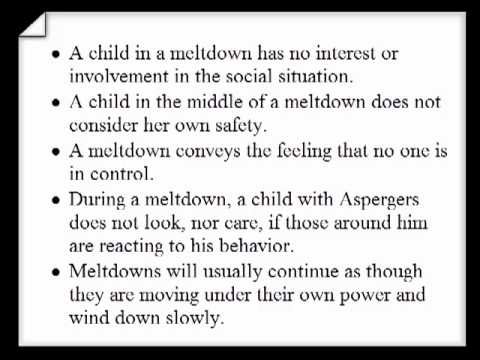 It doesn't matter if a child has a diagnosis or what stage of development he is at, both experienced parents and newcomers are faced with violent emotional outbursts in a child. It's inevitable - if you have a child, you'll deal with behavioral outbursts one way or another.
It doesn't matter if a child has a diagnosis or what stage of development he is at, both experienced parents and newcomers are faced with violent emotional outbursts in a child. It's inevitable - if you have a child, you'll deal with behavioral outbursts one way or another.
If your child is on the autism spectrum, then you have an additional unique parenting skill - the ability to cope with nervous breakdowns. You cannot always predict what will cause a violent scandal or emotional outburst on any given day or in any given environment. To do this, you will have to be superparents with an infinite set of tools and limitless flexibility and sixth sense.
Neither behavioral scandals nor nervous breakdowns look attractive, but in many families of children with autism they happen very often and can be a source of serious stress. It is very important to understand the difference between these two phenomena. Although both may look like a "hysteria," a scandal and a nervous breakdown are not the same thing, and they require completely different approaches.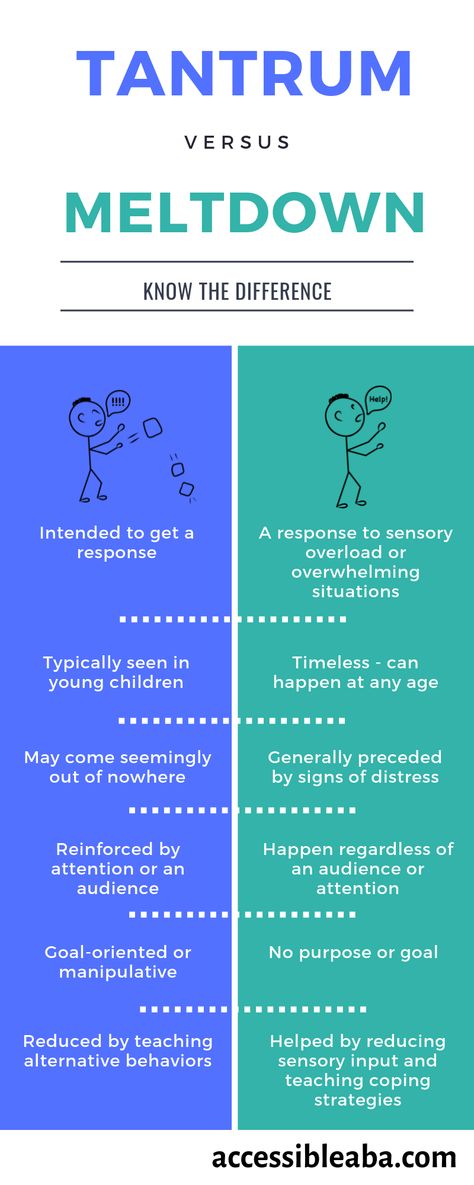
What is a "scandal"?
Scandal or behavioral outburst usually occurs when a child is denied what he wants or cannot do what he wants to do.
Parents often face constant scandals at the age of 2-3 years of the child, or during the so-called "crisis of three years", when young children begin to assert their independence. In fact, the “crisis of three years” is a developmental stage that usually takes place between the ages of 1 and 4 years, because the child needs time to develop the necessary motor, speech and thinking skills.
Preschool children are often prone to "scandals" because they lack the skills needed to cope with difficult situations on their own. Why is this happening? There are several reasons for this:
- They have a desire to be independent, but they lack the motor and cognitive skills (the ability to plan, coordinate and execute actions) to actually BECOME independent.
- In addition, their speech skills are just beginning to develop, so it is difficult for a child to express what he wants and what he needs, and such difficulties can drive him crazy.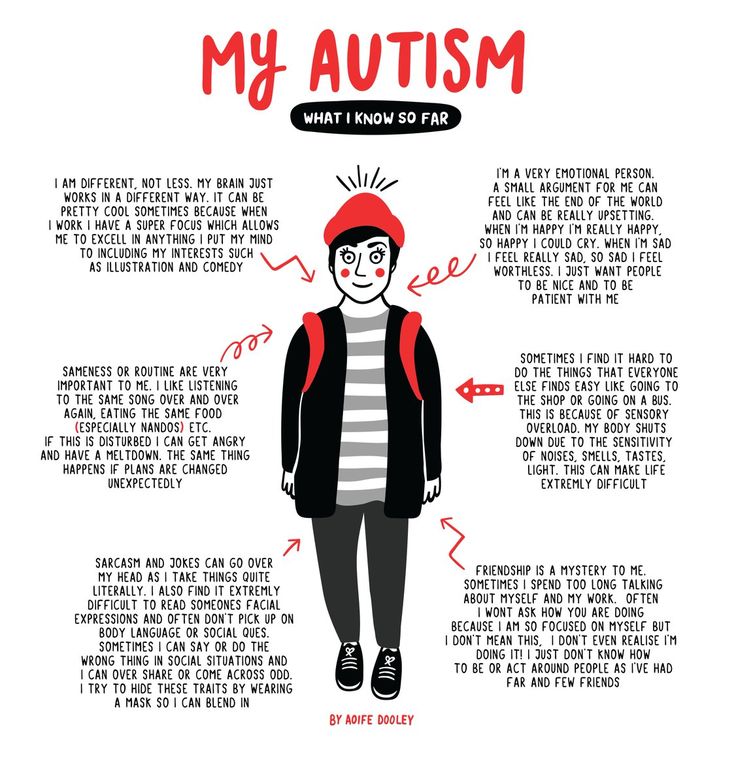
- The child's prefrontal cortex is still underdeveloped. This is the part of the brain that is responsible for emotional regulation and social behavior. The child literally has no ability to regulate his behavior!
- As the child begins to understand the world around him more and more, this very world can cause him anxiety. Such anxiety, coupled with insufficient control over the environment, often leads to behavioral outbursts - it is simply difficult for a child to cope with everything that is happening around.
A key feature of such scandals is that this behavior persists and intensifies if you somehow pay attention to the child during the explosion. If you start consistently ignoring the child when he "scandals", the outbursts will subside.
When a child "scandals", he retains the ability to control his behavior, this behavior may increase or decrease depending on the behavior of adults around him. The scandal stops when the child gets what he wants, or when he realizes that the outbreak will not lead to the desired result.
If parents 'give in' during outbreaks from time to time, children will start arguing again and again, since this behavior has proven effective if they are denied what they want.
As children mature, they develop self-regulation skills to deal with anxiety and anger. If the "tantrum"-like behavioral outbursts are not appropriate for the child's developmental stage, it can lead to great social and emotional difficulties due to inappropriate behavior.
What is a "nervous breakdown"?
A nervous breakdown occurs when a child loses control of his behavior and can only calm down when he reaches the stage of exhaustion.
A nervous breakdown is a reaction to overload, for example, very often the result of excessive sensory stimulation. Scandals can lead to nervous breakdowns, so it's often difficult to distinguish between these two behavioral outbursts if you don't understand the child's sensory responses well.
When a person with autism experiences too much stimulation from the environment, it can lead to an overload of the central nervous system, which loses the ability to process incoming information.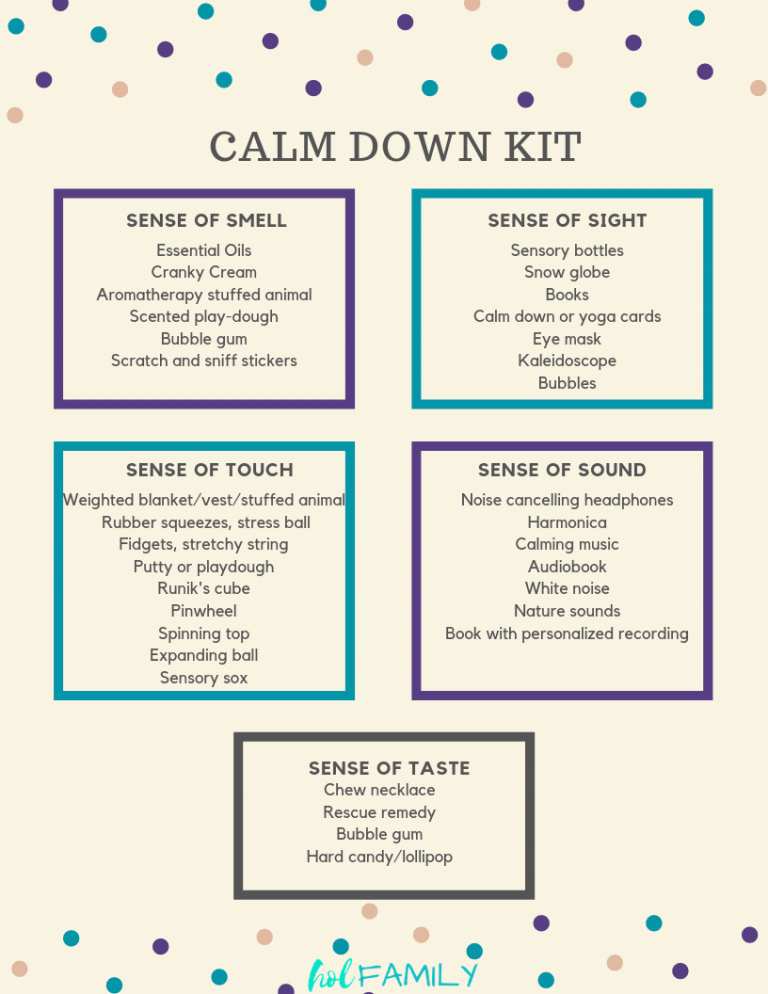 This is actually a physiological "traffic jam" in the central nervous system, and behavior in response to sensory overload is the problematic behavior of a driver who is stuck in traffic. Imagine that you are calmly driving to your destination, humming your favorite song, and then suddenly the highway is completely up. Now you can’t continue on your way, your expectations of the situation have not been met at all, you are surrounded by huge trucks, you are inhaling exhaust fumes, you are deafened by car horns, and your car windows are in direct sunlight. Anxiety about the situation itself is heightened by all these sensations, and you start sensory overload. The last thing you want is to stay in this traffic jam, but you have no way out. Irritation and overexertion are normal reactions in such a situation. Maybe you turn off the radio, close your eyes, try to take deep breaths to calm down (a socially acceptable desirable behavior). OR you jump out of the car and yell in a fit of rage (unwanted maladaptive behavior).
This is actually a physiological "traffic jam" in the central nervous system, and behavior in response to sensory overload is the problematic behavior of a driver who is stuck in traffic. Imagine that you are calmly driving to your destination, humming your favorite song, and then suddenly the highway is completely up. Now you can’t continue on your way, your expectations of the situation have not been met at all, you are surrounded by huge trucks, you are inhaling exhaust fumes, you are deafened by car horns, and your car windows are in direct sunlight. Anxiety about the situation itself is heightened by all these sensations, and you start sensory overload. The last thing you want is to stay in this traffic jam, but you have no way out. Irritation and overexertion are normal reactions in such a situation. Maybe you turn off the radio, close your eyes, try to take deep breaths to calm down (a socially acceptable desirable behavior). OR you jump out of the car and yell in a fit of rage (unwanted maladaptive behavior).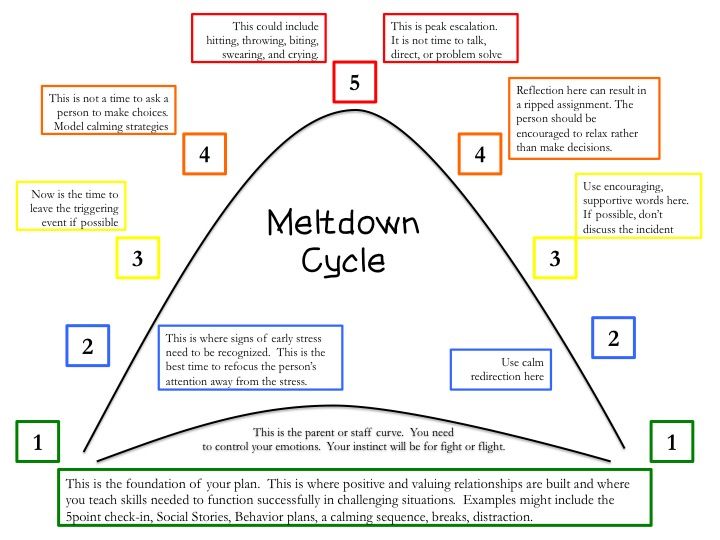
During times of increased anxiety and stress, the sympathetic part of our autonomic nervous system starts producing the hormone cortisol and triggers the fight or flight response. When people with autism or sensory processing dysfunction experience sensory overload, they are unable to regulate sensory signals from the environment, and their bodies begin to perceive these signals as a huge threat.
In moments of a nervous breakdown, control over behavioral reactions is lost. And it is very important to remember this - you cannot expect logical and rational answers in a situation where the child's body perceives ordinary sensory signals as an attack.
Because of this difference in control over one's behavior, strategies for a scandal and a nervous breakdown must be very different.
How can scandals be dealt with?
Strategies for dealing with scandals come down to positive behavioral support and the development of alternative behaviors. There are now many books and articles adapted for parents on how to deal with unwanted child behavior. Most of these approaches boil down to three main strategies:
Most of these approaches boil down to three main strategies:
1. Definition of motivation, that is, the purpose of behavior.
It is important to understand that when a child "scandals" this behavior has a specific purpose. Typically, a behavioral scandal serves a child in one of the following ways: to get the attention of other people (for example, parents), to get some objects or activities (that the child wants, but was denied or access to them is delayed), or to avoid something. - something he doesn't like.
Once you understand WHY the child is fighting, you will be able to understand how you can react to it. Recognize the needs of the child, but do not give in to him in response to the scandal.
2. Encouragement of positive behaviour.
Start "catching" the child when he behaves well. For example, when he does NOT make a fuss in response to small problems, praise him and reward him for good behavior. Depending on what your child prefers, it could be a hug, a high-five, or a good job.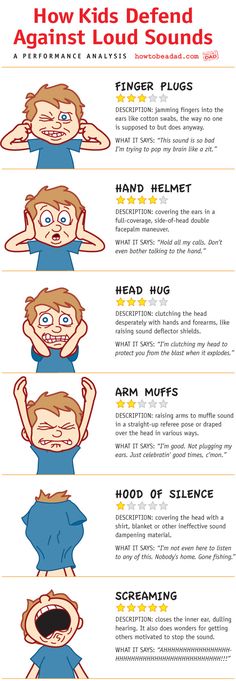 This is how you teach your child that he can get your attention not only through "bad" behavior, but also through "good" behavior. Focusing on what the child did right will help the child build on those successes and behave more positively in the future!
This is how you teach your child that he can get your attention not only through "bad" behavior, but also through "good" behavior. Focusing on what the child did right will help the child build on those successes and behave more positively in the future!
3. Develop skills for success.
We know that a child's frequent fights can indicate a lack of patience, a lack of a way to communicate one's desires, a lack of knowledge of what behavior is expected in a given situation, an inability to comfort oneself. It is important to look for opportunities to develop these skills in your child and help them be successful. However, it is important to work on these skills every day and NOT when the child is fighting.
Strategies for Breakdowns in Children with Autism
You've probably heard the expression, "If you know one person with autism, you know one person with autism." Each child with autism responds differently to different situations, has different skill levels, and different sensory, communication and social profiles, so there is no single strategy that will help with any child's breakdown.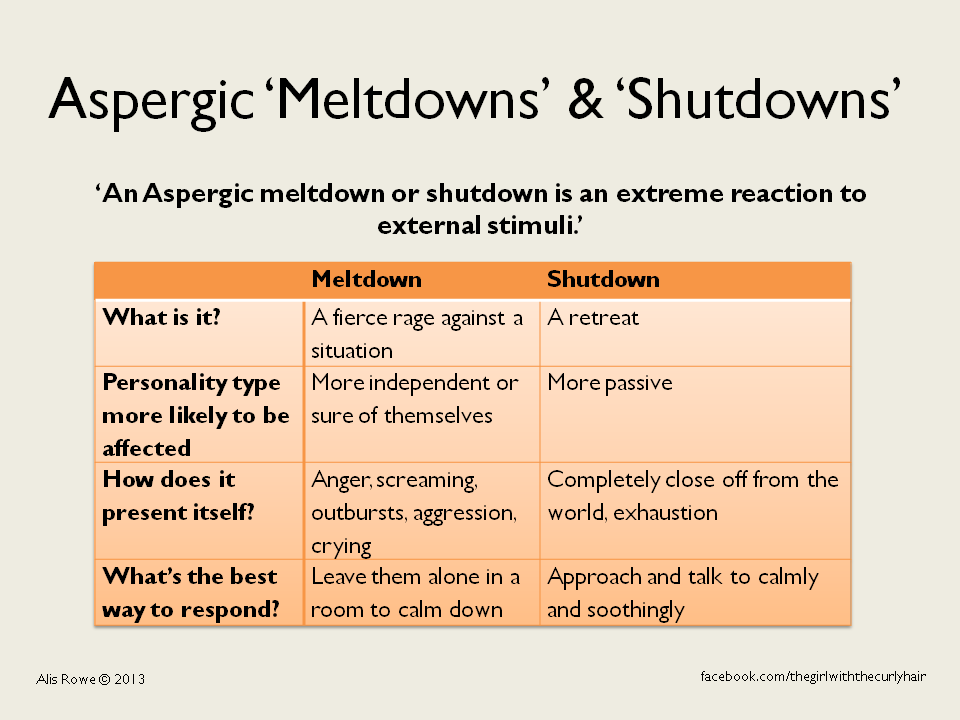 Below are a few tips and strategies that have helped other parents, but you need to consider how they fit the individual child:
Below are a few tips and strategies that have helped other parents, but you need to consider how they fit the individual child:
1. Visual schedules for the day, social stories, to-do lists, schedules for a specific event or task
We all would like to completely avoid nervous breakdowns, but this is impossible. Instead, strategies that reduce stress and anxiety in everyday life, and therefore reduce the risk of a nervous breakdown, can be very helpful. Visual timetables, social stories, checklists, and other visual support help your child become aware of what is expected of him and what is expected of him. For example, if you are planning a trip to the store, then search the Internet for photos of this particular store, place them in the child’s visual schedule for the day. Or, if you have the opportunity, go to the store without your child and film your trip to the store, then watch the video with your child at home. Or write a social story with illustrations about going to the store, what it is for, and what will happen from the beginning to the end of such an event, and read the story with your child.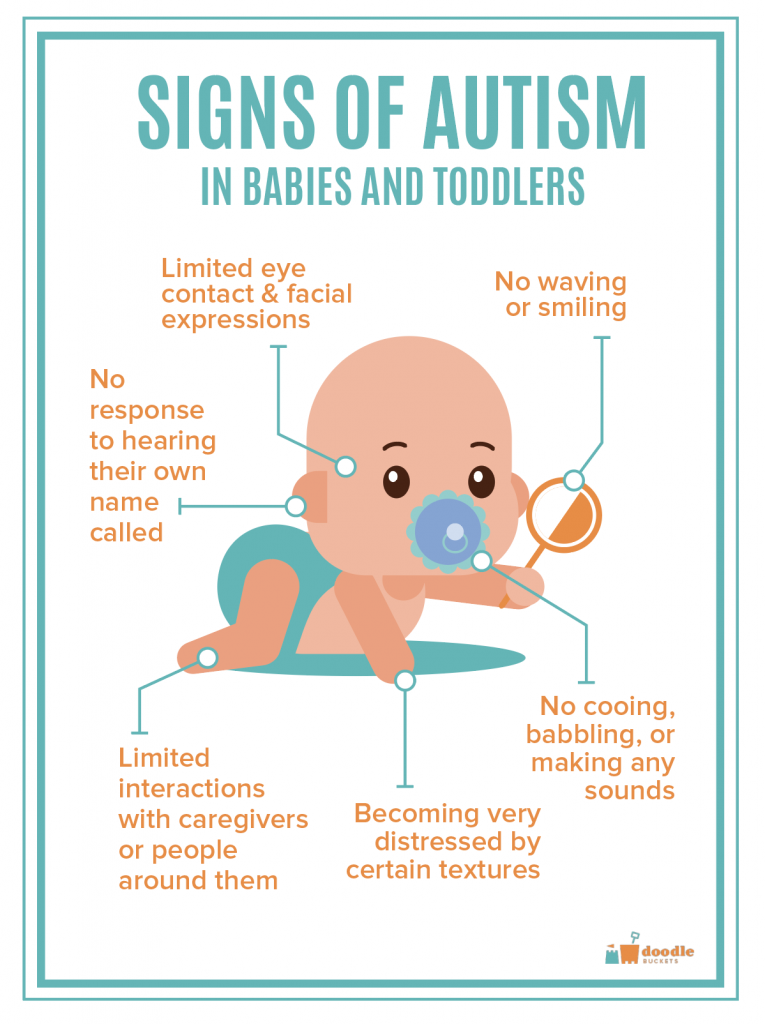 Such strategies create predictability and a sense of control for the child, which reduces anxiety. Over time, also teach your child “surprises” in the schedule so that he can cope with unexpected events in the usual daily routine.
Such strategies create predictability and a sense of control for the child, which reduces anxiety. Over time, also teach your child “surprises” in the schedule so that he can cope with unexpected events in the usual daily routine.
2. Regular "sensory unloading" in the child's schedule.
Regular sensory unloading, the so-called "sensory diet", is an important component that helps the child to regulate his condition during the day. Some parents have found it helpful to prevent breakdowns by scheduling regular “quiet times” for their children, rather than waiting for the events of the day to overwhelm them. This is important to take into account, especially if you are planning visits to new and noisy places for the child. Since a nervous breakdown is the result of many different environmental stimuli whose effect "accumulates", it is best to schedule some quiet time with relaxing sensory activities before going out in public with your child.
3.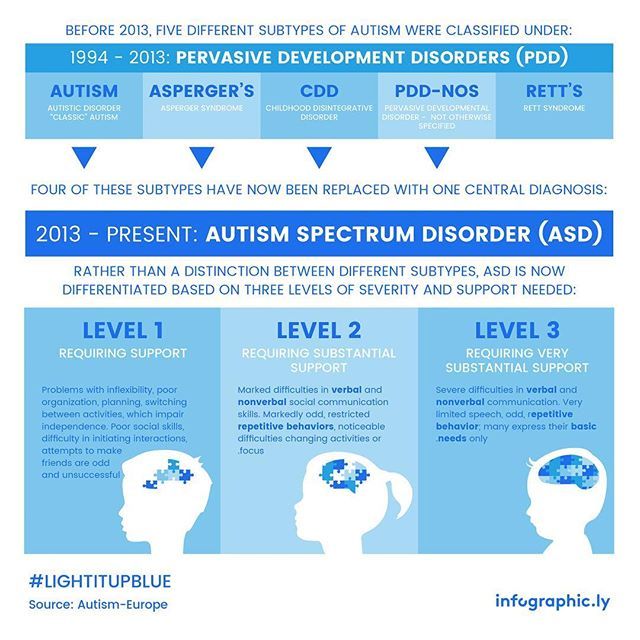 Knowing the signs of severe stress in a child.
Knowing the signs of severe stress in a child.
Another important strategy is to be aware of the first signs that a child is under severe stress. Does the child press his hands to his ears? Runs out of the room? Repeats "Go away!" or "Let's go home!", or do you notice a sharp increase in repetitive behavior (for example, the child sways, hums under his breath, shakes his hands)? These signs of extreme stress may indicate that the child is being over stimulated and needs your help to regulate before they develop into a full-blown breakdown.
If the child is unable to speak, or their language skills become unreliable or lost during a nervous breakdown, they will need some form of non-technological alternative communication, such as a “choice board” where the child points to one of the images from a few to explain what he wants. The child may use alternative communication to let you know when they need to leave the situation or use a different strategy to bounce back.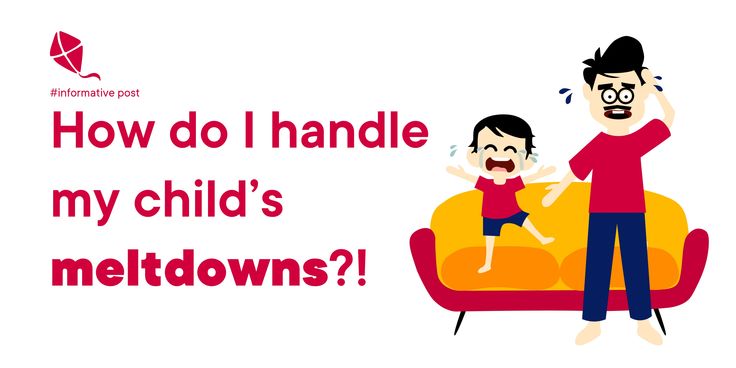
Some children need a predetermined sign that both of you understand (hand gesture, signal word) to communicate sensory overload and thus ask for help.
4. Finding a quiet and safe space.
If you have a nervous breakdown, it is important to find a quiet and safe place. This may mean that you need to leave a place that causes overstimulation (for example, a store). The safe space may also include techniques that reduce sensory information. Remain calm, keep speech to a minimum and, if possible, be silent, offer the child deep pressure, such as hugs, to calm down. If the child is likely to run away or his behavior could become dangerous to himself or others, he may need to be restrained for safety.
Outsiders in public places may not understand the situation and their behavior may exacerbate the crisis. It is helpful to make special cards in case of a nervous breakdown - these are cards made by parents that explain the diagnosis of the child and the reasons for his cries, why he is held, or other behavior that may alert other people.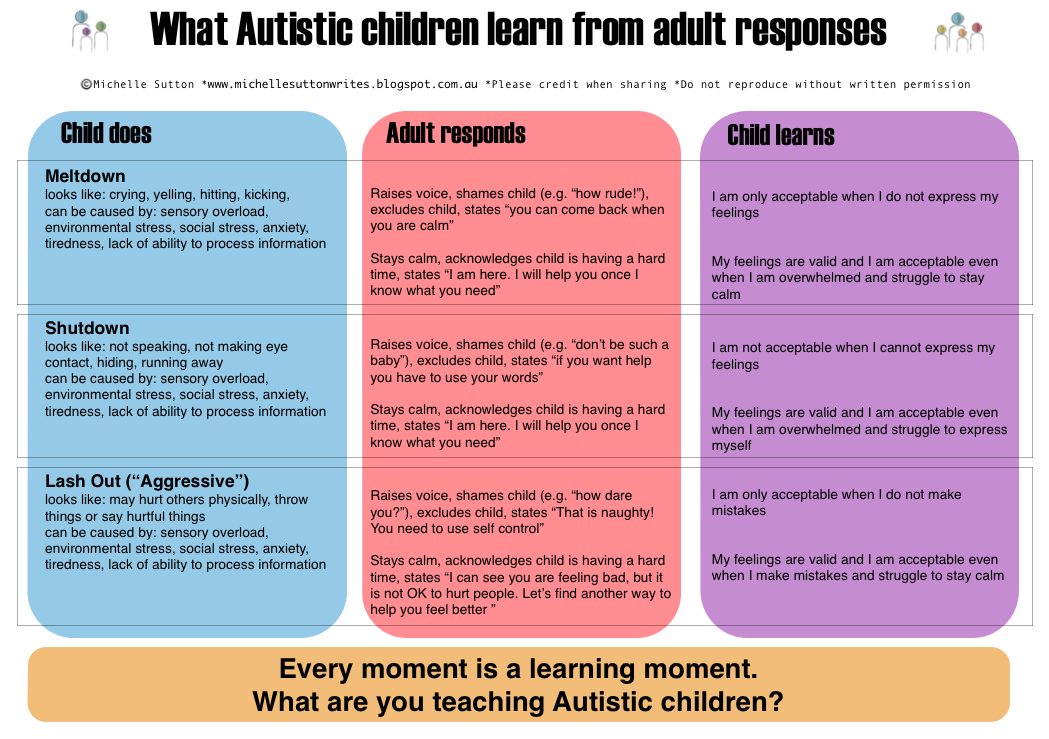 When you're focusing on a child's breakdown, a ready-made card that can be held out silently can save you from unnecessary explanations or false accusations of abuse.
When you're focusing on a child's breakdown, a ready-made card that can be held out silently can save you from unnecessary explanations or false accusations of abuse.
5. Remember to breathe.
This is not so much a strategy for the child as it is for you. Breathe, try not to take what is happening with the child at your own expense. As difficult as it may be, try to notice your emotional reactions (anger, embarrassment, sadness). Remind yourself that your child has lost the ability to control his reactions at the moment. By staying calm and in control of yourself, you are already doing a lot to help your child get through this difficult moment.
6. Portable sensory set for the prevention of nervous breakdowns.
Here are some examples of what parents carry outside the home to prevent a nervous breakdown or to help their child calm down after one.
- Sunglasses (if you are sensitive to bright light).
- Earmuffs (to reduce noise or to distract the child with music).
- Wide-brimmed hat or cap (as a way to distance yourself from social interaction and block out the light from above).
- Snack that can be crunched or chewed for a long time (stimulation of the muscles in the mouth can have a calming effect, and hungry children become more irritable).
- Unscented wet wipes (to help with tactile sensitivity if the child accidentally touches something that irritates him).
- Hand lotion with a favorite scent (may help reduce environmental odors as well as provide a soothing effect).
- A "sensory" toy is a toy that can be used to make repetitive, simple movements that can have a calming effect.
- Communication board with pictures or printed words, eg "I need a break", "Let's go", "Too loud".
- Explanation cards or other way to let strangers know what's going on and why you're reacting the way you do.
The main thing to remember is that nervous breakdowns due to overload are important to distinguish from scandals when a child tries to get his way, since they require different approaches.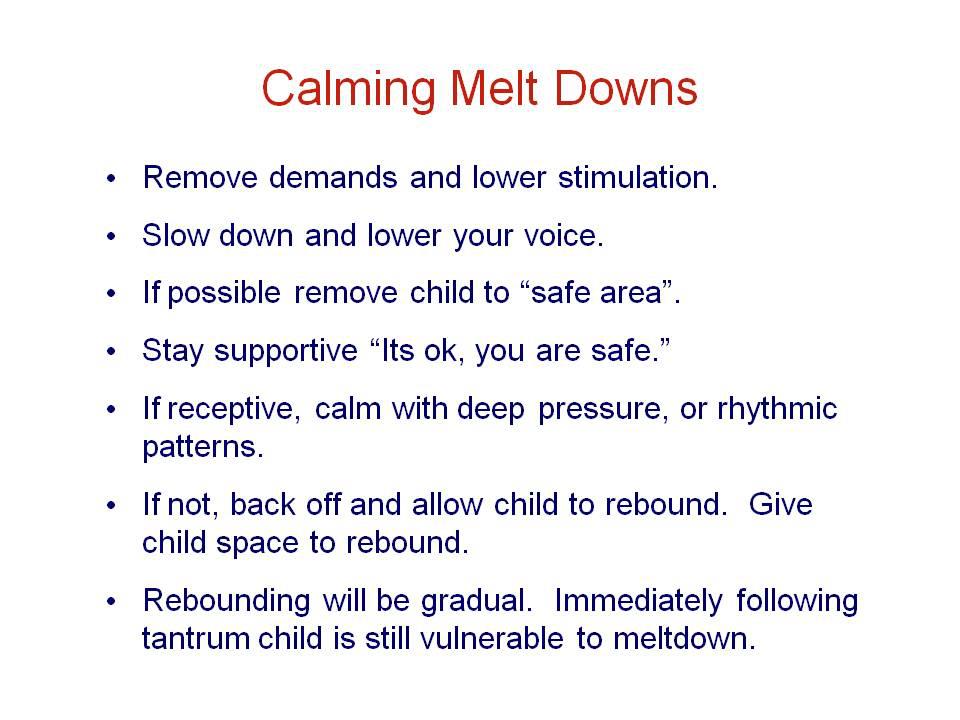 Both phenomena are extremely unpleasant for all involved, so it is important to put as much effort as possible into actively teaching the child how he can regulate his emotional state. Try to find strategies that work best for your child. Just remember to breathe and stay calm.
Both phenomena are extremely unpleasant for all involved, so it is important to put as much effort as possible into actively teaching the child how he can regulate his emotional state. Try to find strategies that work best for your child. Just remember to breathe and stay calm.
See also:
Autistic Meltdown or Temper Tantrum? by Judy Endow, MSW.” Ollibean. N.p., 10 Nov. 2016. Web. 25 May 2017.
“26 Sensory Integration Tools for Meltdown Management – Friendship Circle – Special Needs Blog.” Friendship Circle - Special Needs Blog. N.p., 18 Nov. 2015. Web. 25 May 2017.
Bennett, David D. “Decreasing Tantrum/Meltdown Behaviors of School Children with High Functioning Autism through Parent Training.” social science. N.p., 04 Feb. 2014. Web. May 25, 2017.
Caroline Miller. “Why Do Kids Have Tantrums and Meltdowns?” Child Mind Institute. N.p., n.d. Web. May 25, 2017.
Morin, Amanda. “The Difference Between Tantrums and Sensory Meltdowns.”Understood.